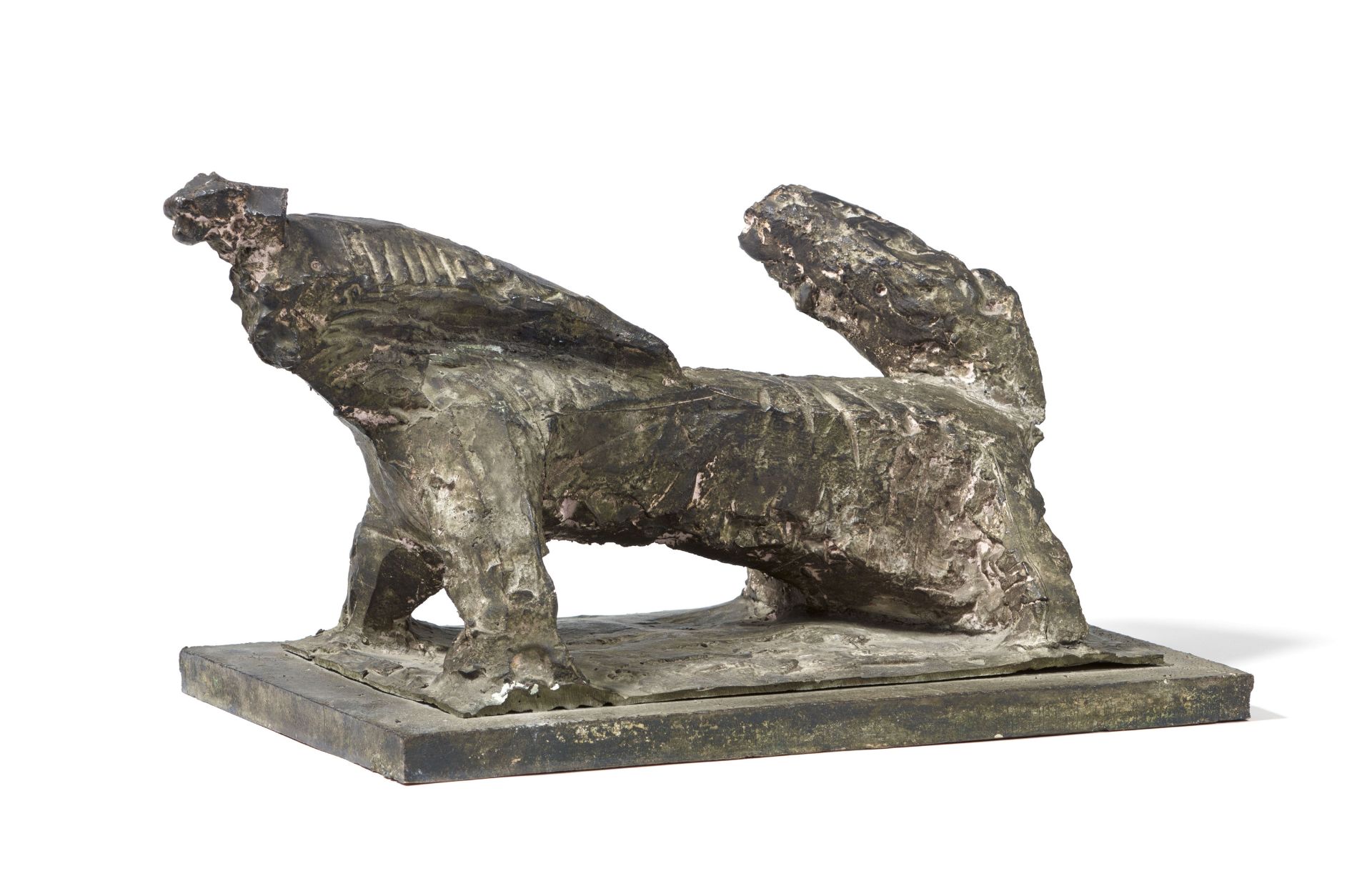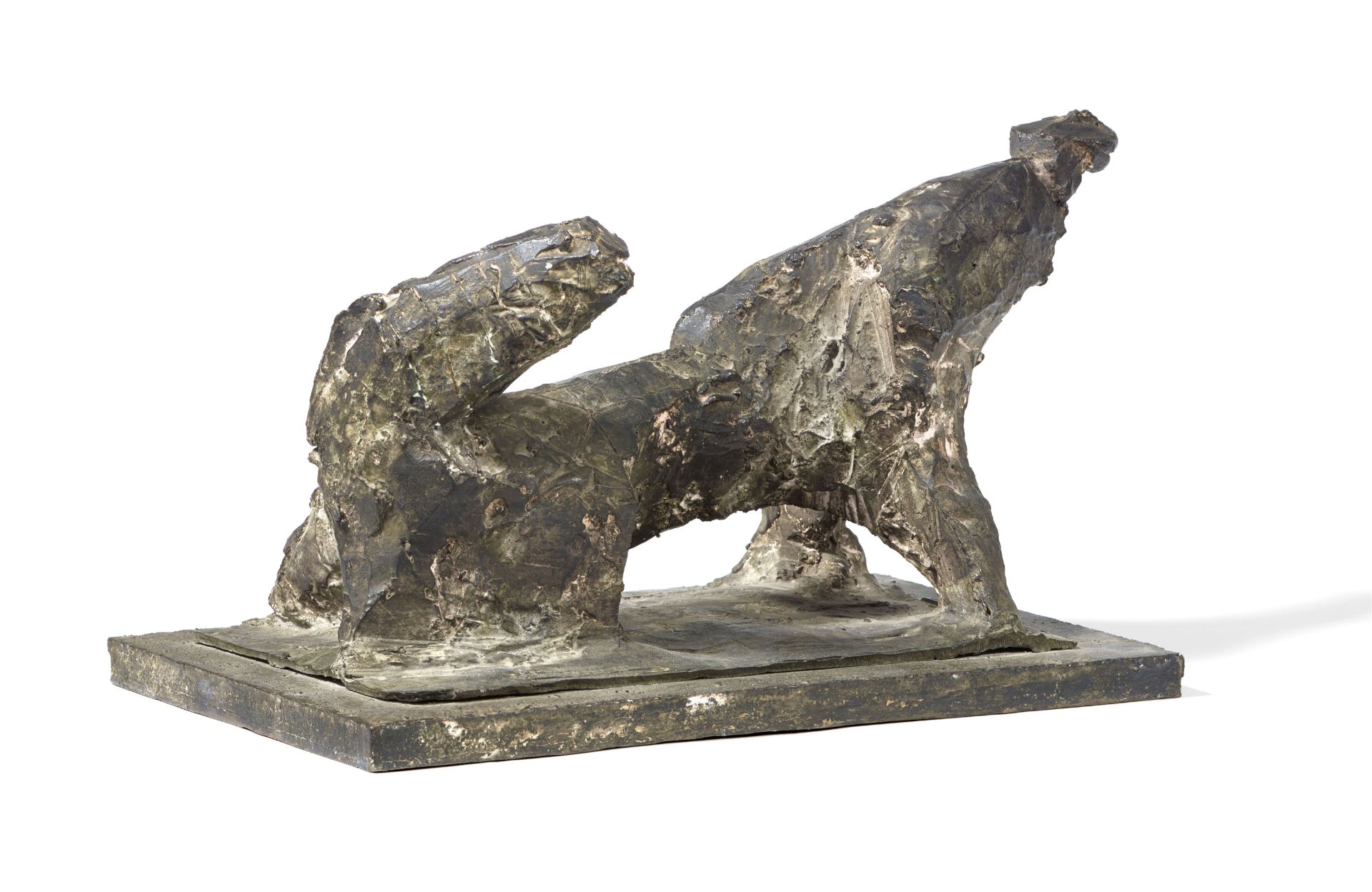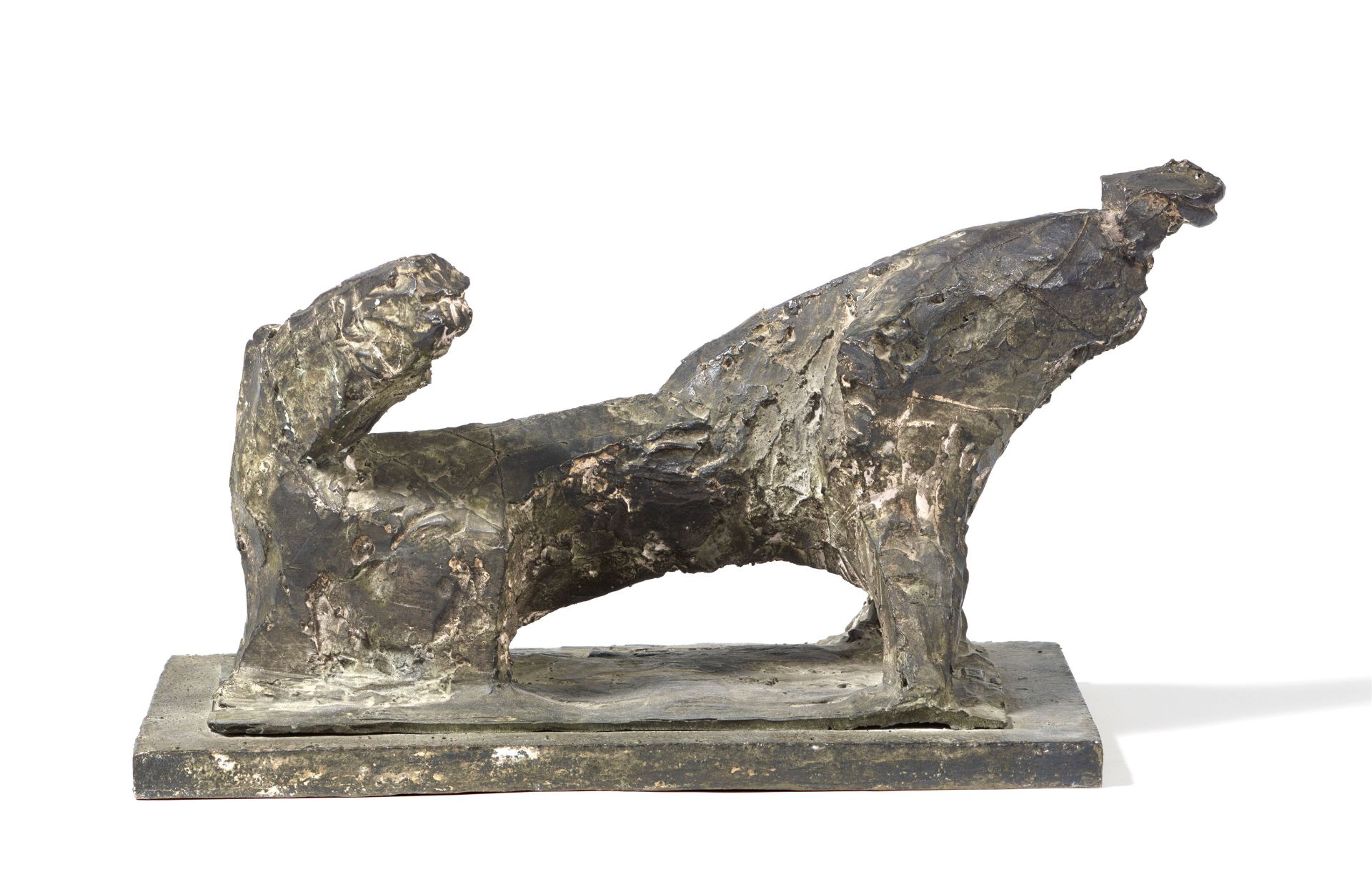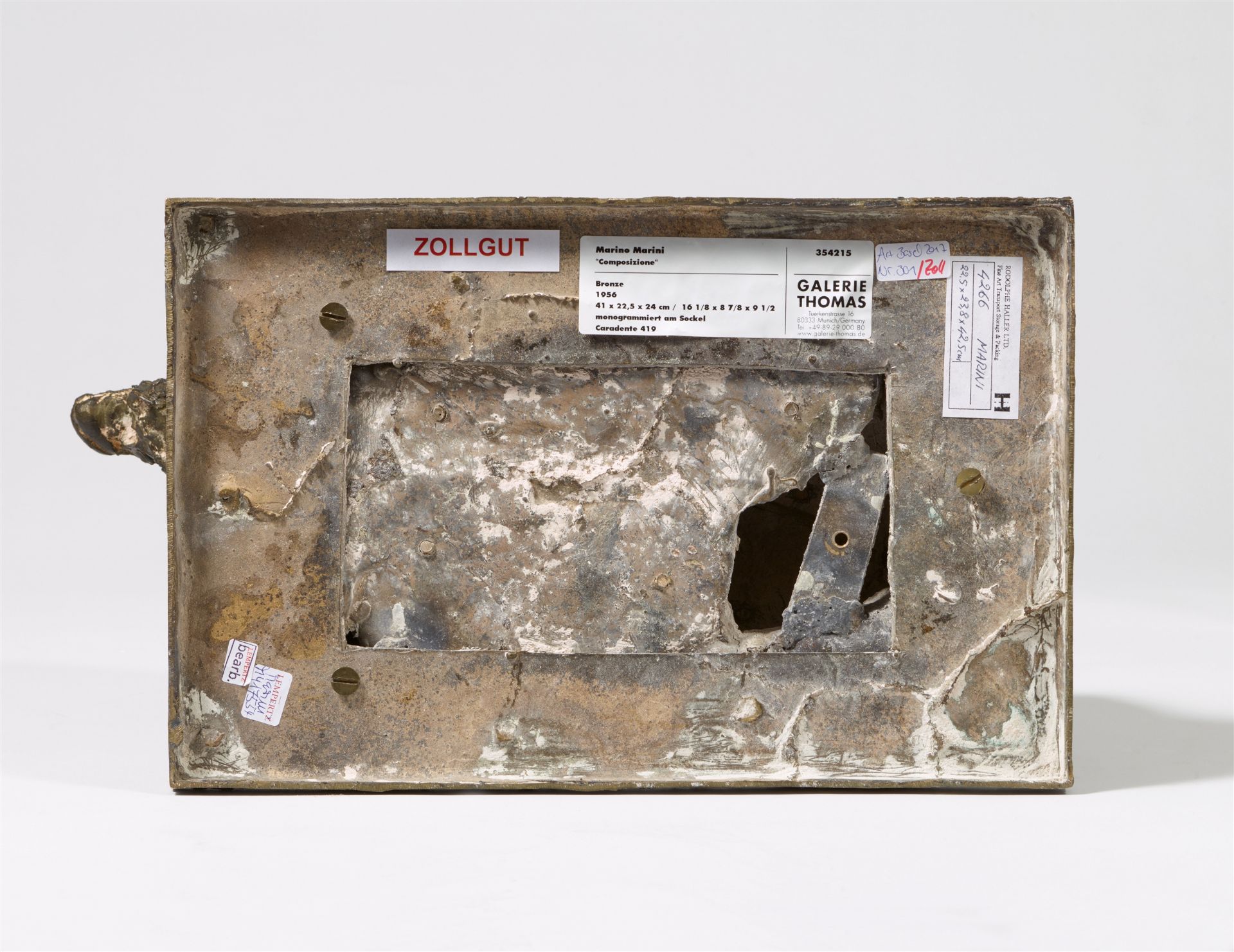4
Marino Marini, Composizione
Bronze. Height 22.5 cm. Width 42 cm. Depth 23.8 cm. Monogrammed 'MM' to narrow side of plinth. One of five casts. - Anthracite-olive-coloured, partly lighter patina.
Carandente 419
With a photo-certificate from Maria Teresa Tosi, Comitato Scientifico della Fondazione Marino Marini, Pistoia, from 13 Nov. 2003
Provenance
Collection Drs A.M. Mees, Wassenaar, the Netherlands (probably since the 1950s); private collection, Switzerland (since the 1980s); Galerie Thomas, Munich (gallery label on underside); private collection, Switzerland
Exhibitions
Cf. Rotterdam 1962 (Boijmans van Beuningen), Nederlanders verzamelen Hedendaagse Kunst, cat. no. 73; Tokyo 1978 (National Museum of Art), Marino Marini, cat. no. 74, p. 118
Literature
Cf. Franco Russoli, Marino Marini. Pitture e Disegni, Mailand 1963, p. 163, no. 16; Herbert Read/Patrick Waldberg/Gualtieri di San Lazzaro, Marino Marini. Leben und Werk, Frankfurt/Berlin/Vienna 1971, p. 374, no. 347; Carlo Pirovano, Marino Marini. Scultore, Milan 1972, no. 353; Marco Meneguzzo, Marino Marini. Cavalieri, Milan 1997, p. 230, cat. no. 98 with ill.
The painter and sculptor Marino Marini was born in Pistoia, Tuscany, in 1901 and his oeuvre revolves around two central themes: first, the world of female dancers and acrobats and, second, riders with their horses. The 1956 sculpture of a fallen horse with rider offered here comes from the latter group, which was particularly important for his late work. Due to its very advanced level of abstraction, it bears the title “Composizione”.
It was chance circumstances that introduced Marini to the horse-and-rider motif around 1930. When he was appointed to a teaching position at the Scuola d’Arte di Villa Reale in Monza, his first studio was located in direct vicinity of a stable: “I utilised the easy opportunity”, he writes, “and made drawings and models of horses almost every day. Back then they were still far removed from having a subjective and apocalyptic meaning for me” (cited by Bartsch, in: Marino Marini, Exhib. Cat. Recklinghausen 2003, p. 39). The theme of the horse – with or without a rider – would never relinquish its grip on him. However, following his experiences in the Second World War, the rider groups began to change; from that point onward, he created ill-treated or rearing horses. A new shift occurred around 1955, when Marini began depicting falling horses whose reeling riders are only just able to maintain their grip. In his late work, where these sculptures are referred to as “Guarrieri” (“Warriors”), he usually depicts the horses as completely on the ground. Often the riders’ presence can only be sensed through details, such as their startled gestures. In the work entitled “Composizione”, a schematic image of the horse’s turned head and the figure leaning back in the opposite direction can still be recognised.
Marino experienced two world wars. He felt a need to engage artistically with these and other continuing conflicts. He primarily gave accusatory expression to his dismay through reeling and, later, falling horses: “My rider statues express the fear that the events of my era instil in me. The anxiety of my horses grows with each new work […]. In this way I seek to create a symbol for the final stage in the dissolution of a myth, the myth of the heroic, victorious individual” (cited, pp. 39-40).
Bronze. Höhe 22,5 cm. Breite 42 cm. Tiefe 23,8 cm. Auf der Plinthe an der Schmalseite monogrammiert 'MM'. Eines von 5 Exemplaren. - Mit anthrazit-olivfarbener, teils hellerer Patina.
Carandente 419
Mit einer Foto-Expertise von Maria Teresa Tosi, Comitato Scientifico della Fondazione Marino Marini, Pistoia, vom 13. November 2003
Provenienz
Sammlung Drs A.M. Mees, Wassenaar, Niederlande (vermutlich seit den 1950er Jahren); Privatsammlung Schweiz (seit den 1980er Jahren); Galerie Thomas, München (Galerie-Etikett unter der Standfläche); Privatsammlung Schweiz
Ausstellungen
Vgl. Rotterdam 1962 (Boijmans van Beuningen), Nederlanders verzamelen Hedendaagse Kunst, Kat. Nr. 73; Tokyo 1978 (National Museum of Art), Marino Marini, Kat. Nr. 74, S. 118.
Literatur
Vgl. Franco Russoli, Marino Marini. Pitture e Disegni, Mailand 1963, S. 163, Nr. 16; Herbert Read/Patrick Waldberg/Gualtieri di San Lazzaro, Marino Marini. Leben und Werk, Frankfurt/Berlin/Wien 1971, S. 374, Nr. 347; Carlo Pirovano, Marino Marini. Scultore, Mailand 1972, Nr. 353; Marco Meneguzzo, Marino Marini. Cavalieri, Mailand 1997, S. 230, Kat. Nr. 98 mit Abb.
Das Schaffen des 1901 in Pistoia, Toskana, geborenen Malers und Bildhauers Marino Marini kreist um zwei zentrale Themen: die Welt von Tänzerinnen und Akrobaten sowie um Reiter mit ihren Pferden. Aus der letztgenannten, vor allem im Spätwerk wichtigen Werkgruppe kommt die 1956 entstandene Skulptur eines gestürzten Pferdes mit seinem Reiter zum Aufruf. Aufgrund wohl ihres hohen Abstraktionsgrads führt sie den Titel „Composizione“.
Um 1930 stieß Marini durch zufällige Lebensumstände auf das Pferd-und-Reiter-Motiv. Als er als Lehrer an die Scuola d’Arte di Villa Reale in Monza berufen wurde, befand sich sein erstes Atelier in unmittelbarer Nähe zu einem Pferdestall: „Ich benutzte die gute Gelegenheit“ schrieb er, „und machte fast jeden Tag Zeichnungen und Modelle von Pferden. Damals waren sie noch weit davon entfernt, etwas Subjektives und Apokalyptisches für mich zu bedeuten.“ (zit. nach Bartsch, in: Marino Marini, Ausst. Kat. Recklinghausen 2003, S. 39) Das Thema des Pferdes mit oder ohne einen Reiter ließ ihn fortan nicht mehr los. Nach den Erfahrungen im Zweiten Weltkrieg begannen die Reitergruppen sich aber zu verändern; fortan entstanden geschundene oder sich aufbäumende Pferde. Um 1955 stellte sich ein erneuter Wandel ein, denn Marini zeigte nun stürzende Pferde, auf denen sich die Reiter nur noch taumelnd halten können. Im Spätwerk, in dem er diese Arbeiten als „Guarrieri“ – „Krieger“ bezeichnete, konzipierte er die Pferde meist komplett am Boden. Durch Details wie hochfahrende Gesten lässt sich der Reiter häufig nur noch erahnen. Bei der als „Composizione“ betitelten Arbeit sind der gedrehte Kopf des Pferdes und dazu gegenläufig die sich nach hinten lehnende Figur noch schemenhaft zu erkennen.
Marino hatte zwei Weltkriege miterlebt. Diese und die dauernden Konflikte zwangen ihn zur künstlerischen Auseinandersetzung. Seine Bestürzung brachte er vor allem mit schwankenden, später stürzenden Pferden anklagend zum Ausdruck: „Meine Reiterstatuen drücken die Beängstigung aus, die mir die Ereignisse meines Zeitalters verursachen. Die Unruhe meiner Pferde wächst mit jedem neuen Werk […]. Ich suche so das letzte Stadium in der Auflösung eines Mythos zu versinnbildlichen, des Mythos vom heldenhaften, siegreichen Individuum.“ (op. cit.S. 39 f.).
Bronze. Height 22.5 cm. Width 42 cm. Depth 23.8 cm. Monogrammed 'MM' to narrow side of plinth. One of five casts. - Anthracite-olive-coloured, partly lighter patina.
Carandente 419
With a photo-certificate from Maria Teresa Tosi, Comitato Scientifico della Fondazione Marino Marini, Pistoia, from 13 Nov. 2003
Provenance
Collection Drs A.M. Mees, Wassenaar, the Netherlands (probably since the 1950s); private collection, Switzerland (since the 1980s); Galerie Thomas, Munich (gallery label on underside); private collection, Switzerland
Exhibitions
Cf. Rotterdam 1962 (Boijmans van Beuningen), Nederlanders verzamelen Hedendaagse Kunst, cat. no. 73; Tokyo 1978 (National Museum of Art), Marino Marini, cat. no. 74, p. 118
Literature
Cf. Franco Russoli, Marino Marini. Pitture e Disegni, Mailand 1963, p. 163, no. 16; Herbert Read/Patrick Waldberg/Gualtieri di San Lazzaro, Marino Marini. Leben und Werk, Frankfurt/Berlin/Vienna 1971, p. 374, no. 347; Carlo Pirovano, Marino Marini. Scultore, Milan 1972, no. 353; Marco Meneguzzo, Marino Marini. Cavalieri, Milan 1997, p. 230, cat. no. 98 with ill.
The painter and sculptor Marino Marini was born in Pistoia, Tuscany, in 1901 and his oeuvre revolves around two central themes: first, the world of female dancers and acrobats and, second, riders with their horses. The 1956 sculpture of a fallen horse with rider offered here comes from the latter group, which was particularly important for his late work. Due to its very advanced level of abstraction, it bears the title “Composizione”.
It was chance circumstances that introduced Marini to the horse-and-rider motif around 1930. When he was appointed to a teaching position at the Scuola d’Arte di Villa Reale in Monza, his first studio was located in direct vicinity of a stable: “I utilised the easy opportunity”, he writes, “and made drawings and models of horses almost every day. Back then they were still far removed from having a subjective and apocalyptic meaning for me” (cited by Bartsch, in: Marino Marini, Exhib. Cat. Recklinghausen 2003, p. 39). The theme of the horse – with or without a rider – would never relinquish its grip on him. However, following his experiences in the Second World War, the rider groups began to change; from that point onward, he created ill-treated or rearing horses. A new shift occurred around 1955, when Marini began depicting falling horses whose reeling riders are only just able to maintain their grip. In his late work, where these sculptures are referred to as “Guarrieri” (“Warriors”), he usually depicts the horses as completely on the ground. Often the riders’ presence can only be sensed through details, such as their startled gestures. In the work entitled “Composizione”, a schematic image of the horse’s turned head and the figure leaning back in the opposite direction can still be recognised.
Marino experienced two world wars. He felt a need to engage artistically with these and other continuing conflicts. He primarily gave accusatory expression to his dismay through reeling and, later, falling horses: “My rider statues express the fear that the events of my era instil in me. The anxiety of my horses grows with each new work […]. In this way I seek to create a symbol for the final stage in the dissolution of a myth, the myth of the heroic, victorious individual” (cited, pp. 39-40).
Bronze. Höhe 22,5 cm. Breite 42 cm. Tiefe 23,8 cm. Auf der Plinthe an der Schmalseite monogrammiert 'MM'. Eines von 5 Exemplaren. - Mit anthrazit-olivfarbener, teils hellerer Patina.
Carandente 419
Mit einer Foto-Expertise von Maria Teresa Tosi, Comitato Scientifico della Fondazione Marino Marini, Pistoia, vom 13. November 2003
Provenienz
Sammlung Drs A.M. Mees, Wassenaar, Niederlande (vermutlich seit den 1950er Jahren); Privatsammlung Schweiz (seit den 1980er Jahren); Galerie Thomas, München (Galerie-Etikett unter der Standfläche); Privatsammlung Schweiz
Ausstellungen
Vgl. Rotterdam 1962 (Boijmans van Beuningen), Nederlanders verzamelen Hedendaagse Kunst, Kat. Nr. 73; Tokyo 1978 (National Museum of Art), Marino Marini, Kat. Nr. 74, S. 118.
Literatur
Vgl. Franco Russoli, Marino Marini. Pitture e Disegni, Mailand 1963, S. 163, Nr. 16; Herbert Read/Patrick Waldberg/Gualtieri di San Lazzaro, Marino Marini. Leben und Werk, Frankfurt/Berlin/Wien 1971, S. 374, Nr. 347; Carlo Pirovano, Marino Marini. Scultore, Mailand 1972, Nr. 353; Marco Meneguzzo, Marino Marini. Cavalieri, Mailand 1997, S. 230, Kat. Nr. 98 mit Abb.
Das Schaffen des 1901 in Pistoia, Toskana, geborenen Malers und Bildhauers Marino Marini kreist um zwei zentrale Themen: die Welt von Tänzerinnen und Akrobaten sowie um Reiter mit ihren Pferden. Aus der letztgenannten, vor allem im Spätwerk wichtigen Werkgruppe kommt die 1956 entstandene Skulptur eines gestürzten Pferdes mit seinem Reiter zum Aufruf. Aufgrund wohl ihres hohen Abstraktionsgrads führt sie den Titel „Composizione“.
Um 1930 stieß Marini durch zufällige Lebensumstände auf das Pferd-und-Reiter-Motiv. Als er als Lehrer an die Scuola d’Arte di Villa Reale in Monza berufen wurde, befand sich sein erstes Atelier in unmittelbarer Nähe zu einem Pferdestall: „Ich benutzte die gute Gelegenheit“ schrieb er, „und machte fast jeden Tag Zeichnungen und Modelle von Pferden. Damals waren sie noch weit davon entfernt, etwas Subjektives und Apokalyptisches für mich zu bedeuten.“ (zit. nach Bartsch, in: Marino Marini, Ausst. Kat. Recklinghausen 2003, S. 39) Das Thema des Pferdes mit oder ohne einen Reiter ließ ihn fortan nicht mehr los. Nach den Erfahrungen im Zweiten Weltkrieg begannen die Reitergruppen sich aber zu verändern; fortan entstanden geschundene oder sich aufbäumende Pferde. Um 1955 stellte sich ein erneuter Wandel ein, denn Marini zeigte nun stürzende Pferde, auf denen sich die Reiter nur noch taumelnd halten können. Im Spätwerk, in dem er diese Arbeiten als „Guarrieri“ – „Krieger“ bezeichnete, konzipierte er die Pferde meist komplett am Boden. Durch Details wie hochfahrende Gesten lässt sich der Reiter häufig nur noch erahnen. Bei der als „Composizione“ betitelten Arbeit sind der gedrehte Kopf des Pferdes und dazu gegenläufig die sich nach hinten lehnende Figur noch schemenhaft zu erkennen.
Marino hatte zwei Weltkriege miterlebt. Diese und die dauernden Konflikte zwangen ihn zur künstlerischen Auseinandersetzung. Seine Bestürzung brachte er vor allem mit schwankenden, später stürzenden Pferden anklagend zum Ausdruck: „Meine Reiterstatuen drücken die Beängstigung aus, die mir die Ereignisse meines Zeitalters verursachen. Die Unruhe meiner Pferde wächst mit jedem neuen Werk […]. Ich suche so das letzte Stadium in der Auflösung eines Mythos zu versinnbildlichen, des Mythos vom heldenhaften, siegreichen Individuum.“ (op. cit.S. 39 f.).
Evening Sale - Modern and Contemporary Art
Sale Date(s)
Venue Address
For Kunsthaus Lempertz delivery information please telephone +49 (0)221 9257290.
Important Information
Evening Sale - Modern and Contemporary Art
Evening Sale - Moderne und Zeitgenössische Kunst
Terms & Conditions
1. The art auction house, Kunsthaus Lempertz KG (henceforth referred to as Lempertz), conducts public auctions in terms of § 383 paragraph 3 sentence 1 of the Commercial Code as commissioning agent on behalf of the accounts of submitters, who remain anonymous. With regard to its auctioneering terms and conditions drawn up in other languages, the German version remains the official one.
2. The auctioneer reserves the right to divide or combine any catalogue lots or, if it has special reason to do so, to offer any lot for sale in an order different from that given in the catalogue or to withdraw any lot from the sale.
3. All lots put up for sale may be viewed and inspected prior to the auction. The catalogue specifications and related specifications appearing on the internet, which have both been compiled in good conscience, do not form part of the contractually agreed to conditions. These specifications have been derived from the status of the information available at the time of compiling the catalogue. They do not serve as a guarantee in legal terms and their purpose is purely in the information they provide. The same applies to any reports on an item’s condition or any other information, either in oral or written form. Certificates or certifications from artists, their estates or experts relevant to each case only form a contractual part of the agreement if they are specifically mentioned in the catalogue text. The state of the item is generally not mentioned in the catalogue. Likewise missing specifications do not constitute an agreement on quality. All items are used goods.
4. Warranty claims are excluded. In the event of variances from the catalogue descriptions, which result in negation or substantial diminution of value or suitability, and which are reported with due justification within one year after handover, Lempertz nevertheless undertakes to pursue its rights against the seller through the courts; in the event of a successful claim against the seller, Lempertz will reimburse the buyer only the total purchase price paid. Over and above this, Lempertz undertakes to reimburse its commission within a given period of three years after the date of the sale if the object in question proves not to be authentic. The used items are sold in public auction in which the bidder/buyer can participate in Person. The legal stipulations concerning the sale of consumer goods are not to be applied according to Art. 474 § 1.2 German Commercial Code (BGB).
5. Claims for compensation as the result of a fault or defect in the object auctioned or damage to it or its loss, regardless of the legal grounds, or as the result of variances from the catalogue description or statements made elsewhere due to violation of due dilligence according to §§ 41 ff. KGSG are excluded unless Lempertz acted with wilful intent or gross negligence; the liability for bodily injury or damages caused to health or life remains unaffected. In other regards, point 4 applies.
6. Submission of bids. Lempertz reserves the right to approve bidders for the auction and especially the right to make this approval dependent upon successful identification in terms of § 1 para. 3 GWG. Bids in attendance: The floor bidder receives a bidding number on presentation of a photo ID. If the bidder is not known to Lempertz, registration must take place 24 hours before the auction is due to begin in writing on presentation of a current bank reference. Bids in absentia: Bids can also be submitted either in writing, telephonically or via the internet. The placing of bids in absentia must reach Lempertz 24 hours before the auction to ensure the proper processing thereof. The item must be mentioned in the bid placed, together with the lot number and item description. In the event of ambiguities, the listed lot number becomes applicable. The placement of a bid must be signed by the applicant. The regulations regarding revocations and the right to return the goods in the case of
long distance agreements (§ 312b-d of the Civil Code) do not apply. Telephone bids: Establishing and maintaining a connection cannot be vouched for. In submitting a bid placement, the bidder declares that he agrees to the recording of the bidding process. Bids via the internet: They will only be accepted by Lempertz if the bidder registered himself on the internet website beforehand. Lempertz will treat such bids in the same way as bids in writing.
7. Carrying out the auction: The hammer will come down when no higher bids are submitted after three calls for a bid. In extenuating circumstances, the auctioneer reserves the right to bring down the hammer or he can refuse to accept a bid, especially when the bidder cannot be successfully identified in terms of § 1 para. 3 GWG. If several individuals make the same bid at the same time, and after the third call, no higher bid ensues, then the ticket becomes the deciding factor. The auctioneer can retract his acceptance of the bid and auction the item once more if a higher bid that was submitted on time, was erroneously overlooked and immediately queried by the bidder, or if any doubts regarding its acceptance arise. Written bids are only played to an absolute maximum by Lempertz if this is deemed necessary to outbid another bid. The auctioneer can bid on behalf of the submitter up to the agreed limit, without revealing this and irrespective of whether other bids are submitted. Even if bids have been placed and the hammer has not come down, the auctioneer is only liable to the bidder in the event of premeditation or gross negligence. Further information can be found in our privacy policy at www.lempertz.com/datenschutzerklärung.html
8. Once a lot has been knocked down, the successful bidder is obliged to buy it. If a bid is accepted conditionally, the bidder is bound by his bid until four weeks after the auction unless he immediately withdraws from the conditionally accepted bid. From the fall of the hammer, possession and risk pass directly to the buyer, while ownership passes to the buyer only after full payment has been received.
9. Up to a hammer price of € 600,000 a premium of 26 % calculated on the hammer price plus 19 % value added tax (VAT) calculated on the premium only is levied. The premium will be reduced to 20 % (plus VAT) on any amount surpassing € 600,000 (margin scheme). On lots which are characterized by N, an additional 7 % for import tax will be charged. On lots which are characterized by an R, the buyer shall pay the statutory VAT of 19 % on the hammer price and the buyer’s premium (regular scheme). To lots characterized by an R which are sold and send to a private person in another EU member state, the VAT legislation of this member state is applied, § 3c UStG. Exports to third (i.e. non-EU) countries will be exempt from VAT, and so will be exports made by companies from other EU member states if they state their VAT identification number. For original works of art, whose authors are either still alive or deceased for less than 70 years (§ 64 UrhG), a charge of 1.8 % on the hammer price will be levied for the droit de suite. For payments which amount to € 10,000.00 or more, Lempertz is obliged to make a copy of the photo ID of the buyer according to §3 of the German Money Laundry Act (GWG). This applies also to cases in which payments of € 10,000.00 or more are being made for more than one invoice. If a buyer exports an object to a third country personally, the VAT will be refunded, as soon as Lempertz receives the export and import papers. All invoices issued on the day of auction or soon after remain under provision.
10. Successful bidders shall forthwith upon the purchase pay to Lempertz the final price (hammer price plus premium and VAT) in Euro. Bank transfers are to be exclusively in Euros. We accept payment by cryptocurrencies. The request for an alteration of an auction invoice, e.g. to a person other than the bidder has to be made immediately after the auction. Lempertz however reserves the right to refuse such a request if it is deemed appropriate. The transfer is subject to successful identification (§ 1 para. 3 GWG) of the bidder and of the person to whom the invoice is transferred. Invoices will only be issued to those persons actually responsible for settling the invoices.
11. In the case of payment default, Lempertz will charge 1% interest on the outstanding amount of the gross price per month.. If the buyer defaults in payment, Lempertz may at its discretion insist on performance of the purchase contract or, after allowing a period of grace, claim damages instead of performance. In the latter case, Lempertz may determine the amount of the damages by putting the lot or lots up for auction again, in which case the defaulting buyer will bear the amount of any reduction in the proceeds compared with the earlier auction, plus the cost of resale, including the premium.
12. Buyers must take charge of their purchases immediately after the auction. Once a lot has been sold, the auctioneer is liable only for wilful intent or gross negligence. Lots will not, however, be surrendered to buyers until full payment has been received. Without exception, shipment will be at the expense and risk of the buyer. Purchases which are not collected within four weeks after the auction may be stored and insured by Lempertz on behalf of the buyer and at its expense in the premises of a freight agent. If Lempertz stores such items itself, it will charge 1 % of the hammer price for insurance and storage costs.
13. As far as this can be agreed, the place of performance and jurisdiction is Cologne. German law applies; the German law for the protection of cultural goods applies; the provisions of the United Nations Convention on Contracts for the International Sale of Goods (CISG) are not applicable. Should any provision herein be wholly or partially ineffective, this will not affect the validity of the remaining provisions. Regarding the treatment of personal data, we would like to point out the data protection
notice on our website.













